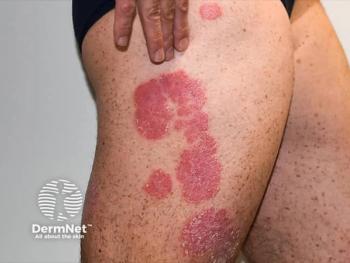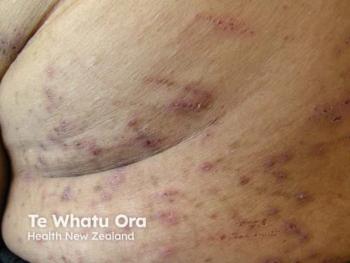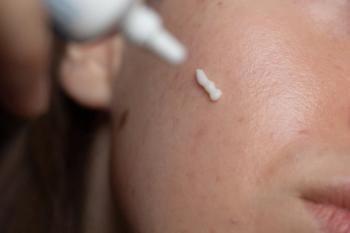
Abrocitinib Shows Age-Linked Safety Differences
Key Takeaways
- Abrocitinib's safety profile varies by age, with older adults experiencing higher rates of adverse events, including serious infections and hematologic abnormalities.
- Herpes zoster and serious infections were notably higher in patients aged 65 and older, linked to JAK-dependent viral immune pathways.
Recent analysis reveals abrocitinib's long-term safety in atopic dermatitis, highlighting age-related risks and the importance of tailored dosing for older patients.
Recent research published in JACI in Practice focused on abrocitinib, a selective Janus kinase 1 (JAK1) inhibitor, approved for the treatment of moderate to severe atopic dermatitis (AD) in patients aged 12 years and older.1 While its efficacy is established, concerns about long-term safety, particularly in older populations, have prompted more detailed evaluations. The integrated safety post analysis, which included 3,802 patients across 5,214 patient-years (PY) of exposure, provides vital insights into age-related safety outcomes.2
Study Design and Population
The analysis stratified patients into 4 age groups: 12 to <18 years, 18 to <40 years, 40 to <65 years, and ≥65 years. Data were pooled from several JADE clinical trials and categorized into consistent-dose and variable-dose cohorts. Incidence rates (IRs) were calculated per 100 PY for treatment-emergent adverse events (TEAEs), serious adverse events (SAEs), and other events of special interest.
Overall Safety Profile
The study concluded that "TEAEs of special interest were lower in adolescents and higher in the 65-years-old or older age group.” Older patients had elevated rates of SAEs, TEAEs leading to discontinuation, serious infections, herpes zoster, and hematologic abnormalities. In contrast, adolescents exhibited the lowest event rates, indicating a favorable safety profile in younger populations.
Infectious Complications
Researchers stated herpes zoster (HZ) was a notable complication, especially in patients ≥65 years. In this group, the analysis found the IRs for HZ were 10.03 (200 mg dose) and 5.61 (100 mg dose) per 100 PY. “HZ is the best-characterized infectious complication of JAKi,” the authors note, attributing this risk to JAK-dependent viral immune pathways. Serious infections also followed this trend, according to researchers, with numerically higher IRs in older age groups.
Hematologic Abnormalities
Thrombocytopenia and lymphopenia were predominantly seen in patients aged 65 and older taking the 200 mg dose. These events were not observed in any age group receiving 100 mg, which researchers stated highlights a dose-related effect. The IR for lymphopenia in patients ≥65 years taking 200 mg was 6.29 per 100 PY, compared to 0.00 in younger cohorts.
Malignancies and Skin Cancers
Incidence of nonmelanoma skin cancer (NMSC) and other malignancies was numerically higher in older patients, according to the analysis, with all NMSC cases occurring in current or former smokers. These findings are consistent with general age-related cancer risk, underscoring the need for vigilance in older, high-risk individuals.
Cardiovascular and Thromboembolic Events
Major adverse cardiovascular events (MACE) and venous thromboembolism (VTE) were more common in older adults. In the ≥65 group, the IR for MACE was 2.64 per 100 PY for the 100 mg dose, and the IR for VTE was 2.64 and 1.04 per 100 PY for the 100 mg and 200 mg doses, respectively. These data align with age-related increases in cardiovascular risk seen in the general population.
Risk Mitigation and Clinical Implications
Despite increased risks in older adults, the authors emphasize that “risk may be minimized in older patients by administering abrocitinib at the lower 100-mg dose.” Individualized dose selection, age-appropriate vaccinations (especially for HZ), and close monitoring are recommended to enhance safety.
Conclusion
The analysis found abrocitinib demonstrates a manageable long-term safety profile across age groups. Adverse events were noted to be more frequent in older adults but remain within a controllable range when dose adjustments and monitoring are applied. These findings support abrocitinib’s continued use in AD treatment, with careful patient selection based on age and comorbidity status.
References
- Breaking news: FDA approves Cibinqo (Abrocitinib). News release. National Eczema Association. Published January 14, 2022. Accessed May 8, 2025. https://nationaleczema.org/cibinqo-approval/
- Cork MJ, Deleuran M, Geng B, et al. Long-term safety of abrocitinib in moderate-to-severe atopic dermatitis: Integrated analysis by age. J Allergy Clin Immunol Pract. Published online March 11, 2025. doi:10.1016/j.jaip.2025.02.040
Newsletter
Like what you’re reading? Subscribe to Dermatology Times for weekly updates on therapies, innovations, and real-world practice tips.


















